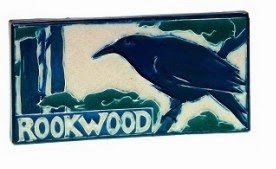Early
Rookwood Pottery advertising tile.
Introduction
The Rookwood Pottery Company was founded in
1880 by Maria Longworth Nichols in Cincinnati, Ohio. Since their inception, the
company continued to produce innovative art pottery for over 100 years. Always
striving to stay ahead of current trends, their styles changed with the times,
new lines being created and old ones being retired. Although they created an
almost mind-boggling assortment of pieces, most collectors know very little
about the earliest of Rookwood art pottery. In this article we shall explore
the various lines, styles, and artists who created these early wares, and help
set Rookwood Pottery on it's journey.
Early
Limoges Rookwood pottery vase with fish.
Limoges and Cincinnati
Faience
When the Rookwood Pottery began, they were
considered the primary innovator of under-glaze painting, which is a process of
applying various colored clay as a palette and painting it onto a piece of
pottery before applying the final glaze. Their early work was referred to as
both "Limoges" from the region in France which had pioneered the
process, and as "Cincinnati Faience" in an attempt to differentiate
it. The Cincinnati Faience style was usually produced on hand-thrown pieces,
often carved and incised, with very thick decoration under the glaze. Some
people refer to this work as "Halloween Rookwood" due to the subject
matter, which often shows various grotesque insects, birds, dragons, fish,
bats, spiders, spiderwebs, and nets. Nearly all of this thick, heavy
under-glaze was created by Maria Longworth Nichols and Albert Humphreys,
although Helen Peachy and several other members of the Cincinnati Pottery Club
are known to have produced some. Very often there is added gold gilding above
the glaze to highlight details. Collectors of Limoges face a daunting task, very
little has survived outside of museums, and pieces by the founder of Rookwood
often come with a hefty price tag. She produced very little after 1883, so this
date is usually assumed as the end of the Rookwood Limoges line.
Lovely
Japanesque Rookwood miniature perfume jug
Japanesque
The addition of several new artists refined
the subject somewhat, adding sparrows, bamboo, owls, and other popular themes
providing a more delicate design. Much of the artwork was taken from various
Japanese texts, and as such is usually referred to as the "Japanesque
Rookwood". The artwork is generally considered not to be a replication of
Japanese style, but more of an interpretation of what Americans thought
Japanese art was at the time. Most of the Japanesque pieces were decorated on
molded pieces, and often on such mundane things as porridge bowls or ginger
jars. Matthew Daly, Joseph Hirschfeld, Martin Rettig, Alfred Brennan, William McDonald, Hattie Horton, Laura Fry, Clara Newton, and Albert Valentien
pioneered these Japanesque styles, mixing various sparrows, butterflys, owls,
cloudy skies, landscapes, bamboo, and floral themes. Many of the artworks were
originally standardized, with all of the artists decorating pieces with the
same image, and they all appear nearly identical. However, very quickly each
artist began developing their own styles and repertoire, expanding the variety
of artwork available. Pieces by Daly and Valentein are considered slightly more
collectible than the other artists in the Japanesque style, but they are
generally not considered much more aesthetically pleasing than the others.
Collectors of Rookwood Japanesque art pottery tend to pay less attention to the
artist and more attention to the overall rarity of the piece and the subject
matter. Most of the the early themes disappeared after 1885 and were replaced
almost completely by floral compositions. This tradition continued somewhat
with the cameo and dull glaze lines, well into the 1890's.
Early
Rookwood vase carved by Harriet Wenderoth.
Incised and Carved
A third, and very
overlooked early style was the production of pieces which were not decorated
under-slip with colors, but instead were carved and incised. Various artists
with talent in woodcarving as well as young schoolgirls were given the
opportunity to decorate pieces and used a variety of methods to produce them.
The simplest methods used nail-heads or dies to create repeating patterns on a
piece of pottery, but some produced very intricate and delicate carvings. Fanny Auckland, William Breuer, Katherine deGolter, Agnes Pittman, and Harriet Wenderoth each have their own unique style, but those pieces which were
hand-carved rather than impressed tend to have a better appeal to collectors.
One notable exception is Ms. Auckland who has found quite a following among
collectors. By 1883 the production of these carved and impressed pieces
vanished, and carved pieces were rarely manufactured again until the Arts and
Crafts period decades later.
Conclusion
Often overlooked by experts, the early Rookwood art pottery lines can provide a rich experience for
collectors looking for unique and interesting pieces to display. Whether it is
the heavy and often grotesque Limoges style of the founder, the delicate
Japanesque style of the early artists, or the true roots of Art and Crafts in
Cincinnati, there is something for everyone. Most major auctions will have a
few such pieces, and collecting them can be a challenging and life-long
endeavor. Aside from auctions, there are many sources on the internet where you
can find Rookwood pottery for sale, although few have the art
pottery desired by collectors of the early works. Now that you know what to
look for, it is time to get out there and find them! Learn more about Rookwood Pottery at the Rookwood Collectors Group.




No comments:
Post a Comment